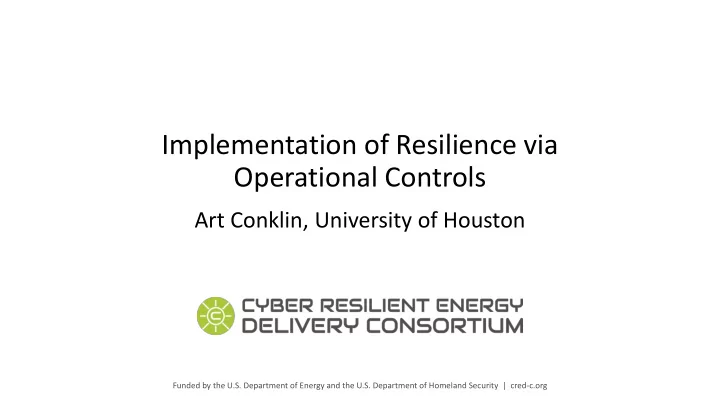

Implementation of Resilience via Operational Controls Art Conklin, University of Houston Funded by the U.S. Department of Energy and the U.S. Department of Homeland Security | cred-c.org
Security in IT vs. OT • IT security • CIA associated with authorized user and data flow • OT security • Continued safe operation of the system regardless of changes in the environment cred-c.org | 2
What is resilience • Cyber Resiliency • “The emergent property of a system that can continue to carry out its mission after disruption that does not exceed its operational limit ” • “The ability of a system to anticipate, withstand, recover from, and/or evolve to improve capabilities in the face of, adverse conditions, stresses, or attacks on the supporting cyber resources it needs to function.” • Anticipate • Withstand • Recover • Evolve cred-c.org | 3
Tools • Policy Layer • BC/DRP/COOP • Resiliency Policies and Procedures Physical Layer • Compute Layer Compute Layer Resilience Control layer • Redundancy • Security Policy Layer • Layers (Purdue Model) • Resilience Control Layer • Safety • Interlocks cred-c.org | 4
System Emergent Property • Must be engineered in to emerge • FMEA - how does system operate under failure situations • Threat Modeling - where does the disruption come from • Safety Systems - Purdue model and isolationism • Determining what is proper is non-trivial - Process specific • What are resilient modes? • What are resilient operations? cred-c.org | 5
Implementation of Resilience via Operational Controls • Resiliency is an emergent property of a system. • Emergent properties are not defined by single system elements • Emerge as a result of system interactions • To achieve resiliency in a system requires specific elements in system design and operation. • Determine how operational controls affect system resiliency. • Operational controls are used to control security – another emergent property. • Controls are used all the time. • Which controls can improve resiliency. cred-c.org | 6
Implementation of Resilience via Operational Controls • This activity looks at how operational controls that are used to achieve specific objectives such as security can be adapted and patterned by use into controls that target greater resiliency. • Create a top 20 resiliency controls list, the objective is to determine and highlight how operational controls can enhance system resiliency. • Production of an operational controls checklist and associated documentation for implementation. • Top 20 Controls – key concept – built from analyzing offense cred-c.org | 7
Top 20 Controls (security in OT) 1. Inventory of Authorized and 11. Malware Defenses Unauthorized Devices 12. Data Recovery Capability 2. Inventory of Software 13. Controlled Use of Administrative 3. Secure Configurations for All Privileges 4. Secure Network Engineering 14. Penetration Tests and Red Team Exercises 5. Limitation and Control of Network Ports, Protocols, and Services 15. Controlled Access Based on the Need to Know 6. Boundary Defense 16. Account Monitoring and Control 7. Secure Configurations for Network Devices 17. Data Loss Prevention 8. Maintenance, Monitoring, and 18. Continuous Vulnerability Analysis of Security Audit Logs Assessment and Remediation 9. Security Skills Assessment and 19. Application Software Security Appropriate Training to Fill Gaps 20. Wireless Device Control 10. Incident Response Capability cred-c.org | 8
How to get to resiliency • What is offense in OT • Loss of View • Anticipate • Loss of Control • Withstand • Recover • Denial of View • Evolve • Denial of Control • Denial of Safety • Apply to controls • Manipulation of View • Manipulation of Control • Manipulation of Safety cred-c.org | 9
• Anticipate Top 20 Controls (resiliency in OT) • Withstand 1. Inventory of Authorized and 11. Malware Defenses Unauthorized Devices • Recover 12. Data Recovery Capability 2. Inventory of Software 13. Controlled Use of • Evolve 3. Secure Configurations for All Administrative Privileges 4. Secure Network Engineering 14. Penetration Tests and Red Team 5. Limitation and Control of Network Exercises Ports, Protocols, and Services 15. Controlled Access Based on the 6. Boundary Defense Need to Know 7. Secure Configurations for Network 16. Account Monitoring and Control Devices 17. Data Loss Prevention 8. Maintenance, Monitoring, and 18. Continuous Vulnerability Analysis of Security Audit Logs Assessment and Remediation 9. Security Skills Assessment and 19. Application Software Security Appropriate Training to Fill Gaps 20. Wireless Device Control 10. Incident Response Capability cred-c.org | 10
Why we aren’t there • Security controls “defend” the information side of the process including control functions • The process has its own modes and paths • Ever increasing temperature when to recognize, when to control • Steady state vs. stuck • Resilience requires more than normal control • Anticipate • Where are we now • Where are we going • When will we move to extremis cred-c.org | 11
Most action today is withstand in nature • Prevent the hit from hurting us • Now looking at the “ICS Attack Phenomenon” • Malware got on your system (problem #1) • You lose Visibility and Control (problem #2) • Your system no longer really yours (problem #3) • We get #1 – withstand • We need to work on #2 and #3 – this is where we are thinking and working cred-c.org | 12
Next Steps • Look at attack: change of process control logic • How will controls see the change • How will we recognize the change • Today’s controls will see attacks (some) and deviations (some) • Today’s controls cannot see process change • How can NSM give us insight? cred-c.org | 13
Questions? Art Conklin waconklin@uh.edu cred-c.org | 14
Recommend
More recommend